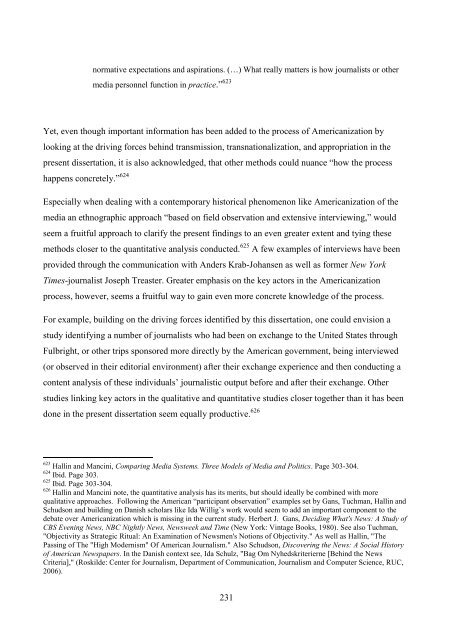The Jeremiad Over Journalism
The Jeremiad Over Journalism
The Jeremiad Over Journalism
You also want an ePaper? Increase the reach of your titles
YUMPU automatically turns print PDFs into web optimized ePapers that Google loves.
normative expectations and aspirations. (…) What really matters is how journalists or other<br />
media personnel function in practice.‖ 623<br />
Yet, even though important information has been added to the process of Americanization by<br />
looking at the driving forces behind transmission, transnationalization, and appropriation in the<br />
present dissertation, it is also acknowledged, that other methods could nuance ―how the process<br />
happens concretely.‖ 624<br />
Especially when dealing with a contemporary historical phenomenon like Americanization of the<br />
media an ethnographic approach ―based on field observation and extensive interviewing,‖ would<br />
seem a fruitful approach to clarify the present findings to an even greater extent and tying these<br />
methods closer to the quantitative analysis conducted. 625 A few examples of interviews have been<br />
provided through the communication with Anders Krab-Johansen as well as former New York<br />
Times-journalist Joseph Treaster. Greater emphasis on the key actors in the Americanization<br />
process, however, seems a fruitful way to gain even more concrete knowledge of the process.<br />
For example, building on the driving forces identified by this dissertation, one could envision a<br />
study identifying a number of journalists who had been on exchange to the United States through<br />
Fulbright, or other trips sponsored more directly by the American government, being interviewed<br />
(or observed in their editorial environment) after their exchange experience and then conducting a<br />
content analysis of these individuals‘ journalistic output before and after their exchange. Other<br />
studies linking key actors in the qualitative and quantitative studies closer together than it has been<br />
done in the present dissertation seem equally productive. 626<br />
623<br />
Hallin and Mancini, Comparing Media Systems. Three Models of Media and Politics. Page 303-304.<br />
624<br />
Ibid. Page 303.<br />
625<br />
Ibid. Page 303-304.<br />
626<br />
Hallin and Mancini note, the quantitative analysis has its merits, but should ideally be combined with more<br />
qualitative approaches. Following the American ―participant observation‖ examples set by Gans, Tuchman, Hallin and<br />
Schudson and building on Danish scholars like Ida Willig‘s work would seem to add an important component to the<br />
debate over Americanization which is missing in the current study. Herbert J. Gans, Deciding What's News: A Study of<br />
CBS Evening News, NBC Nightly News, Newsweek and Time (New York: Vintage Books, 1980). See also Tuchman,<br />
"Objectivity as Strategic Ritual: An Examination of Newsmen's Notions of Objectivity." As well as Hallin, "<strong>The</strong><br />
Passing of <strong>The</strong> "High Modernism" Of American <strong>Journalism</strong>." Also Schudson, Discovering the News: A Social History<br />
of American Newspapers. In the Danish context see, Ida Schulz, "Bag Om Nyhedskriterierne [Behind the News<br />
Criteria]," (Roskilde: Center for <strong>Journalism</strong>, Department of Communication, <strong>Journalism</strong> and Computer Science, RUC,<br />
2006).<br />
231
















